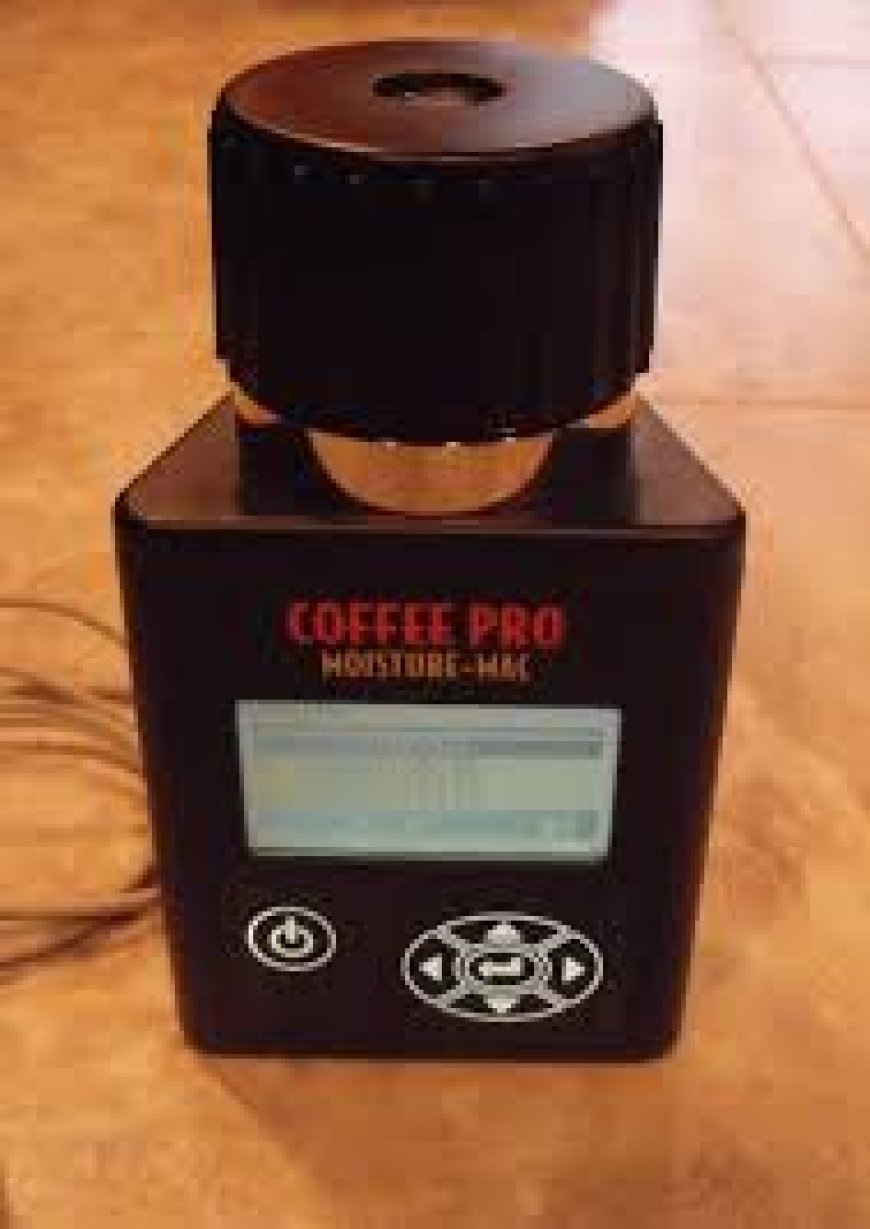Precision Moisture Analyzer for Coffee Labs

Introduction
In the specialized world of coffee quality control, accuracy and consistency determine everythingfrom shelf life to flavor potential. Among the most critical parameters in evaluating green coffee quality is moisture content. A small variance in moisture can affect roasting behavior, storage stability, and overall cup performance. Thats why professional labs and coffee exporters rely on amoisture analyzera precise instrument designed to measure the moisture content of green or roasted coffee beans quickly and accurately.
The importance of moisture analysis in coffee cannot be overstated. Whether you're receiving a new shipment of green beans, preparing for export compliance, or calibrating your roasts, a reliable reading of moisture content helps you maintain product quality, reduce waste, and protect flavor integrity. A professional moisture analyzer doesnt just provide numbersit enables better decision-making across the supply chain.
This article explores the function, types, applications, and benefits of using a moisture analyzer in the coffee industry. Well also look at how Coffee Pro Direct provides high-performance, lab-grade moisture analyzers tailored for coffee professionals at every level.
What Is a Moisture Analyzer?
A moisture analyzer is a laboratory instrument used to determine the moisture content in a sample through heat drying. It combines a weighing mechanism with a halogen or infrared heating unit. The device measures the weight of the sample before and after drying, calculating the percentage of moisture lost through evaporation.
In coffee applications, moisture analyzers are used to test green coffee, parchment coffee, and occasionally roasted coffee to determine if the beans fall within acceptable moisture ranges. Too much moisture increases the risk of mold and degradation, while too little can lead to poor roasting performance and flavor loss.
Typical moisture content guidelines:
-
Green coffee beans: 1012.5%
-
Parchment coffee: 1113%
-
Roasted coffee: 1.54%
By ensuring coffee meets these targets, the moisture analyzer helps maintain safety, quality, and roasting predictability.
Why Moisture Analysis Matters in Coffee
Moisture content influences everything from the integrity of green coffee storage to its roasting profile. Poor moisture control can result in physical defects, microbial contamination, and inconsistencies in flavor expression.
Key reasons moisture matters:
-
Shelf Life: Beans with too much moisture degrade faster
-
Roasting Consistency: Moisture affects heat transfer and development time
-
Weight and Pricing: Moisture adds weightexcess levels can misrepresent true volume
-
Defect Prevention: Prevents fungal growth, mold, or fermentation issues
-
Export Compliance: Required for meeting trade and quality standards
Accurate moisture readings are a non-negotiable part of any cupping lab, green coffee warehouse, or roastery aiming for quality assurance.
How Does a Moisture Analyzer Work?
A moisture analyzer operates using the thermogravimetric principle. The process involves weighing a sample before and after heating, and then calculating the moisture lost as a percentage of the original weight.
Step-by-Step Process:
-
Sample Loading: A small amount (typically 310g) of coffee is placed on the balance tray.
-
Initial Weighing: The analyzer records the initial weight.
-
Heating Begins: Infrared or halogen heating element dries the sample over a controlled time and temperature range.
-
Final Weighing: The machine records the dried weight.
-
Moisture Calculation: The difference in weight is expressed as a moisture percentage.
Advanced moisture analyzers allow customization of temperature profiles, drying times, and auto-stop conditions to ensure reproducibility and precision.
Types of Moisture Analyzers for Coffee Labs
Different models cater to varying needswhether for high-speed readings or detailed analysis.
1. Halogen Moisture Analyzer
Uses halogen heating elements to quickly dry the sample.
-
Pros: Fast, efficient, consistent
-
Best For: Labs needing quick moisture assessments
2. Infrared Moisture Analyzer
Utilizes infrared radiation for more even heating.
-
Pros: Gentle drying, suitable for delicate samples
-
Best For: Specialty labs or samples prone to charring
3. Microwave Moisture Analyzer
Employs microwave energy for rapid and deep heating.
-
Pros: Extremely fast, great for larger samples
-
Best For: Commercial or high-volume processing
4. Capacitive Moisture Meter (Non-Drying)
Measures moisture based on the dielectric properties of the sample.
-
Pros: Instant readings, portable
-
Limitations: Less precise, not ideal for certified labs
Applications of Moisture Analyzers in the Coffee Industry
Moisture analyzers are used across every stage of the coffee supply chainfrom farm to roastery. Their applications help maintain safety, compliance, and quality.
Common use cases:
-
At Origin: Farmers or cooperatives check moisture of parchment to decide drying duration
-
In Warehouses: Verifying that incoming green coffee is within safe moisture range
-
Before Export: Ensuring compliance with import country regulations
-
During Roasting: Monitoring moisture loss for roasting curves
-
In Quality Labs: Cross-checking moisture to validate physical grading and cupping results
Proper moisture analysis prevents spoilage, protects flavor, and aligns stakeholders on product quality.
Benefits of Using a Professional Moisture Analyzer
While handheld meters may offer convenience, a lab-grade moisture analyzer offers significant advantages in terms of reliability, reproducibility, and data tracking.
Performance Benefits:
-
High Accuracy: Readings within 0.01% precision
-
Fast Results: Most tests complete in 510 minutes
-
Repeatable Testing: Eliminates inconsistencies between batches
-
Customizable Settings: Tailored profiles for different coffee types
Business Benefits:
-
Reduces Losses: Prevents spoilage from improper storage
-
Builds Trust: Verifiable data improves transparency with buyers
-
Supports Certification: Meets the requirements of specialty grading systems
-
Boosts Quality Assurance: Integrates into lab SOPs and traceability systems
Moisture analysis doesnt just protect your productit strengthens your reputation as a quality-driven operation.
Features to Look for in a Moisture Analyzer
Choosing the right analyzer depends on your lab needs, coffee types, and daily testing volume. Not all machines are equal, and a few critical features can elevate performance and usability.
Essential Features:
-
Precision Scale: Minimum readability of 0.001g for detailed analysis
-
Temperature Range: Adjustable up to 200250C for full drying control
-
Drying Modes: Standard, fast, stepwise, or gentle drying profiles
-
Display Interface: Easy-to-read, backlit screen with moisture %, time, and status
-
Auto Shut-Off: Stops automatically when constant weight is achieved
-
Calibration Function: Internal or external calibration for accuracy
-
Data Logging: Built-in memory or USB/export functions for record-keeping
Professional labs should always opt for models with verified calibration and service support.
Why Choose Coffee Pro Direct?
At Coffee Pro Direct, we understand the unique demands of specialty coffee labs and roasteries. Thats why we offer moisture analyzers specifically designed for coffee evaluationwith intuitive operation, precise results, and rugged durability.
Why professionals choose Coffee Pro Direct:
-
Coffee-Specific Calibration: Our analyzers are tested with actual green coffee samples for accuracy
-
Fast & Reliable: Get results in under 10 minutes without sacrificing precision
-
Durable Construction: Built to withstand daily lab usage and harsh environments
-
Custom Profiles: Pre-programmed for green, parchment, and roasted beans
-
Compact Design: Fits perfectly on cupping tables or in small lab spaces
-
Service & Support: Backed by expert technicians and global warranty options
-
Trusted Worldwide: Used in labs, cooperatives, and QC centers in over 40 countries
Whether you need one unit for sample validation or multiple machines for export inspections, Coffee Pro Direct provides analyzers you can trustevery time.
Integrating a Moisture Analyzer Into Your Lab Workflow
To get the most value out of your moisture analyzer, it should be integrated into your regular quality control workflow. It plays a key role in verifying samples, adjusting roasting profiles, and approving shipments.
Suggested QC workflow:
-
Receive green sample
-
Use sample divider to extract a portion
-
Measure moisture with Coffee Pro Direct analyzer
-
Log reading into sample database
-
Cupping and physical grading follow if within target range
By including moisture testing at the start, you eliminate inconsistencies and waste further down the process.
Maintenance and Calibration
Maintaining your analyzer is crucial to preserving accuracy and longevity.
Maintenance Tips:
-
Clean trays and chambers daily
-
Avoid overloading the sample
-
Use calibration weights weekly
-
Avoid using oily or roasted coffee unless designed for it
-
Store in a dry, stable temperature environment
Calibrating regularly ensures that the analyzer delivers reliable results, especially in high-volume labs.
Conclusion
In the coffee industry, consistency and control are the cornerstones of quality. The moisture analyzer is one of the most powerful tools in achieving both. It ensures that coffee remains within safe storage thresholds, enables accurate cupping results, and helps roasters calibrate their profiles with confidence.
With moisture content influencing everything from pricing to flavor, it is no longer an optional testits a critical step in quality assurance. From cooperatives at origin to high-end specialty roasters, moisture analyzers provide the data that drive informed decisions.At Coffee Pro Direct, were proud to offer equipment that meets the rigorous demands of todays specialty coffee professionals. Our moisture analyzers are fast, accurate, and built for real-world usegiving you clarity, control, and confidence in every cup.
FAQs
Q1: How much sample do I need for testing?
Typically, a moisture analyzer requires 310 grams of green coffee for accurate measurement. Always consult your specific models manual.
Q2: Can I use a moisture analyzer for roasted coffee?
Yes, though readings may vary due to oil content. Always use a model that supports roasted coffee profiles or opt for green bean analysis when possible.
Q3: How often should I calibrate my moisture analyzer?
Weekly for high-volume labs, or monthly for small operations. Use certified calibration weights and follow the manufacturers instructions.
Q4: Is a halogen moisture analyzer better than infrared?
Halogen analyzers are faster and more commonly used in coffee labs. Infrared analyzers offer gentler drying but may take longer.
Q5: Why choose Coffee Pro Directs moisture analyzers?
Because they are built specifically for coffee professionalsoffering precise readings, durable build, intuitive operation, and global support.


































